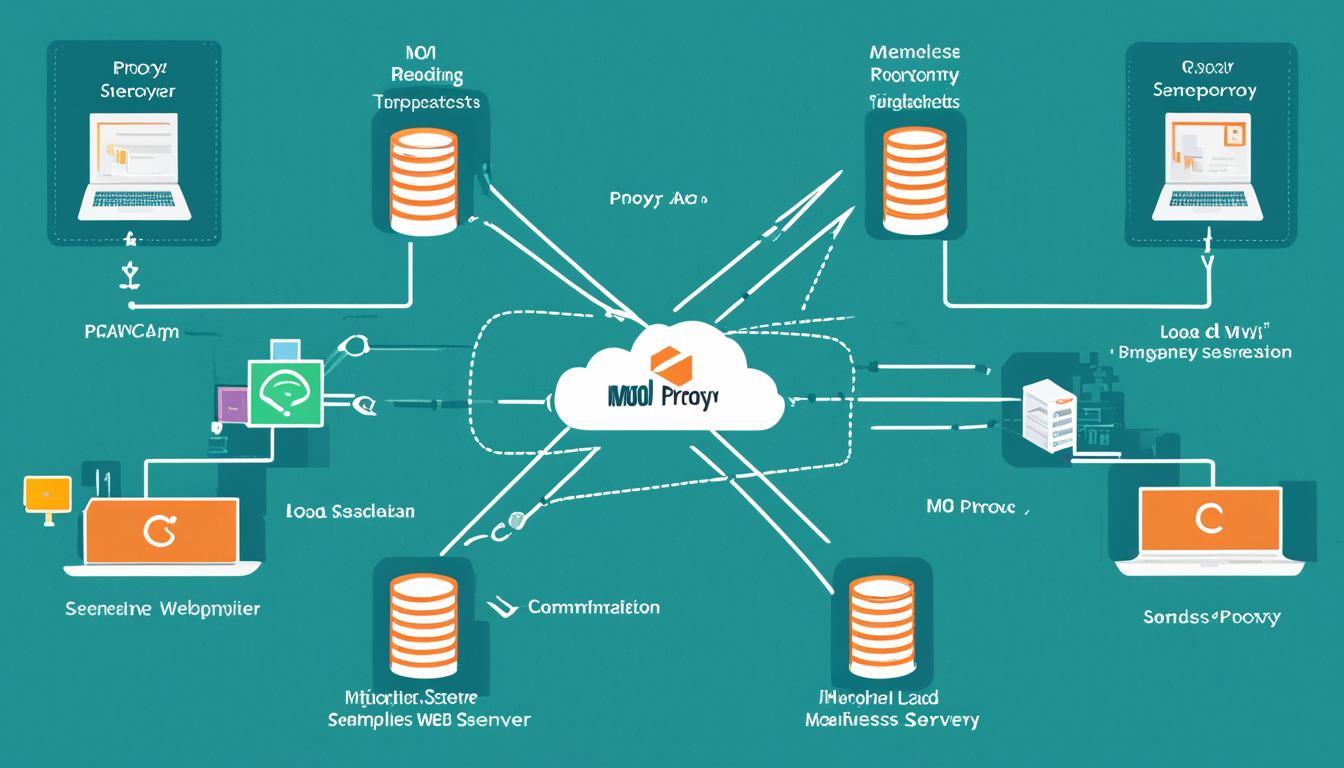What is mod_proxy and Its Uses
Have you ever wondered what mod_proxy is and how it works in Apache? In this article, I will provide a clear explanation of mod_proxy, its uses, and why it is an essential module for the Apache HTTP Server.
Mod_proxy is an extension module for the Apache HTTP Server that acts as a multi-protocol proxy/gateway server. It provides basic proxy capabilities and supports various protocols such as AJP13, FTP, HTTP/0.9, HTTP/1.0, and HTTP/1.1. This means that mod_proxy can handle different types of incoming requests, allowing your server to efficiently communicate with backend servers or devices.
To use mod_proxy, it is important to configure and secure your server properly. Enabling ProxyRequests without securing the server can lead to unauthorized access to your network. Therefore, it is crucial to take measures to prevent any potential security breaches.
Key Takeaways:
- Mod_proxy is an extension module for the Apache HTTP Server.
- It acts as a multi-protocol proxy/gateway server.
- Mod_proxy supports various protocols like AJP13, FTP, and HTTP.
- Configuring and securing your server is essential before enabling ProxyRequests.
How mod_proxy Works
Mod_proxy is a powerful module that serves as an intermediary between clients and backend servers, enabling the interception and forwarding of incoming HTTP requests. By understanding how mod_proxy functions, you can harness its capabilities to streamline your web applications and enhance site management.
Mod_proxy works by intercepting HTTP requests received by the server and determining the appropriate backend server to forward them to. Acting as an intermediary, it facilitates seamless communication between clients and origin servers, ensuring a smooth flow of data.
The functionality of mod_proxy can be tailored to specific requirements through the configuration of various conditions. These conditions can include URL patterns or specific HTTP headers, allowing for precise control over which requests are proxied.
For instance, let’s consider an example where mod_proxy is configured to redirect requests for the “/api” path to a separate backend server that specializes in handling API requests. By implementing this rule, incoming requests targeted at the “/api” path are seamlessly routed to the dedicated backend server responsible for processing API interactions. This ensures efficient management and distribution of incoming requests to multiple backend servers.
By leveraging mod_proxy’s configurable nature, you can easily adapt it to suit your specific needs, optimizing the performance and scalability of your web applications.
Implementing mod_proxy requires a sound understanding of its inner workings and configuration options. Once you grasp the fundamentals, you can unlock the full potential of this module, enabling efficient proxying of requests and enhancing the overall performance of your web environment.
Forward Proxies and Reverse Proxies/Gateways
Mod_proxy can serve as both a forward proxy and a reverse proxy/gateway, catering to diverse network requirements and configurations. Understanding the distinctions between these two proxy types is crucial for deploying mod_proxy effectively.
Forward Proxies
A forward proxy acts as an intermediary between the client and the destination server, facilitating client requests for accessing external websites or services. When a client sends a request through a forward proxy, the proxy server retrieves the requested content on behalf of the client, shielding the client’s identity and location.
Forward proxies are commonly utilized in corporate environments to allow internal clients, secured behind firewalls, to access the wider internet. By channeling all outbound traffic through the forward proxy, organizations can enforce content filtering, security measures, and centralized logging to ensure compliance and protect their internal network.
Reverse Proxies/Gateways
A reverse proxy, on the other hand, appears to the client as a regular web server, accepting incoming requests and then forwarding them to backend servers based on predefined rules. This enables secure access to internal servers or services that are hidden behind a firewall.
Reverse proxies serve multiple purposes, such as providing internet users access to internal web servers without exposing their IP addresses or internal network details. Additionally, they offer load balancing functionalities by distributing incoming requests across multiple backend servers, enhancing performance and ensuring high availability.
Reverse proxies are commonly utilized in large-scale web applications, CDN (Content Delivery Network) setups, or server clusters where balancing the load among multiple servers is essential for efficient and resilient operations.
Understanding the role of forward and reverse proxies in the mod_proxy module allows network administrators to implement appropriate configurations based on their specific requirements and security needs.
Benefits of Using mod_proxy
When it comes to web applications and site management, using mod_proxy provides numerous benefits that can greatly enhance your system’s performance, security, and flexibility. Let’s explore the advantages that make mod_proxy a valuable tool.
Secure Access to Internal Resources
One of the significant benefits of mod_proxy is its capability to provide a secure gateway for accessing internal resources without exposing them directly to the internet. By acting as an intermediary, it adds a layer of protection for your sensitive information and prevents unauthorized access.
Load Balancing for Improved Performance
Another advantage of mod_proxy is its ability to distribute incoming requests to multiple backend servers, effectively balancing the load and improving overall performance. This feature ensures that no single server becomes overwhelmed, resulting in faster response times and enhanced user experience.
Increased Fail-Safeness
By utilizing mod_proxy, you can achieve a higher level of fail-safeness for your web applications. With load balancing, the system automatically redirects traffic to other available servers if one server experiences downtime or becomes unresponsive. This redundancy minimizes the risk of service disruptions and improves the reliability of your application.
Enhanced Features with Caching, Compression, and SSL Encryption
Besides its primary functionalities, mod_proxy offers additional features that can further optimize your web application’s performance. It supports caching mechanisms, allowing frequently accessed content to be stored locally and served faster. Moreover, mod_proxy can handle compression of data, reducing bandwidth requirements and improving network efficiency. Additionally, it provides the ability to enable SSL encryption for secure communication between the client and the backend servers, adding an extra layer of protection against potential threats.
Overall, the benefits of using mod_proxy encompass enhanced security, load balancing, fail-safeness, and additional features to optimize your web applications. Its versatility and functionality make it an invaluable tool for site management and delivering a seamless user experience.
Configuration and Directives
Configuring mod_proxy involves enabling the necessary modules and loading them into the server. These modules include mod_proxy, mod_proxy_balancer for load balancing, and protocol-specific modules like mod_proxy_http or mod_proxy_ajp. Once these modules are enabled, you can use various directives to define the behavior of mod_proxy and configure its settings.
The following table provides an overview of some commonly used mod_proxy directives:
| Directive | Description | ||
|---|---|---|---|
|
Specifies the backend server to proxy requests to based on a URL pattern. | ||
|
Adjusts the URLs in the responses from the backend server to match the proxy’s URL space. | ||
|
Enables or disables the proxy functionality. | ||
|
Preserves the original host header from the client request when proxying. | ||
|
Sets the timeout value for proxy connections. |
In addition to these directives, there are many other configuration options available for mod_proxy. These options allow you to control access to the proxy, configure caching, set connection limits, and more.
Here’s an example of a mod_proxy configuration:
This configuration proxies all requests to the “/api” path to a backend server located at “http://backend-server/api”. The
1 | ProxyTimeout |
directive sets the timeout for proxy connections to 60 seconds.
Important Considerations
When configuring mod_proxy, it’s essential to ensure the security and stability of your server. Here are a few important considerations:
- Limit access to the proxy to prevent unauthorized use and potential security vulnerabilities.
- Regularly monitor and update the modules and directives used in your mod_proxy configuration to stay up-to-date with security patches and improvements.
- Test your configuration thoroughly to ensure proper functionality and performance.
By carefully configuring mod_proxy and its directives, you can customize its behavior and optimize proxying to suit your specific needs.

Load Balancing with mod_proxy
Mod_proxy, an extension module for the Apache HTTP Server, offers load balancing capabilities through the mod_proxy_balancer module. By defining multiple backend servers as balancer members, you can distribute incoming requests across these servers, enhancing performance and ensuring fail-safeness.
To configure load balancing with mod_proxy, you can use directives such as BalancerMember and ProxyPass. These directives allow you to specify the backend servers to which requests should be proxying, facilitating load distribution. Moreover, to determine how requests are distributed among the backend servers, the mod_lbmethod_byrequests module provides multiple load balancing algorithms, including round-robin and least-connections.
Example:
To illustrate the load balancing feature of mod_proxy, consider a scenario where a high-traffic website needs to handle incoming requests efficiently across three backend servers. By configuring mod_proxy with the appropriate directives, the module can evenly distribute the requests among these servers, ultimately improving the website’s performance and ensuring a seamless user experience.
Load Balancing Algorithm Comparison
| Algorithm | Description |
|---|---|
| Round-robin | The requests are evenly distributed among backend servers in a circular manner. Each request is routed to the next available server. |
| Least-connections | The requests are directed to the server with the fewest active connections. This algorithm helps balance the load based on the current server workload. |
| Random | The requests are sent to backend servers randomly, without considering the current server load or connection counts. This algorithm can be suitable for certain scenarios where equal distribution is not a priority. |
Using mod_proxy for Web Applications
Mod_proxy is a powerful tool that allows you to set up virtual hosts for web applications, enabling you to partition separate websites and applications on a single server. This feature is particularly valuable when hosting multiple web frameworks or applications on the same server, as it simplifies management and improves performance.
The process involves configuring mod_proxy to proxy requests to specific backend servers based on the requested URL. By doing so, you can easily direct incoming requests to the appropriate backend server, ensuring that each web application receives the necessary resources and support.
For example, let’s say you have a server hosting two different web applications: Application A and Application B. With mod_proxy, you can configure the server to proxy all requests for www.yourdomain.com/appA to the backend server running Application A, while requests for www.yourdomain.com/appB are proxied to the backend server running Application B.
This allows you to maintain separate environments for each application, enhancing security and isolating potential issues. Additionally, using mod_proxy for web applications enables you to take advantage of load balancing capabilities, further optimizing performance.
Advantages of Using mod_proxy for Web Applications
By utilizing mod_proxy for web applications, you can reap several benefits:
- Easily manage multiple web applications on a single server, simplifying administration and reducing resource usage.
- Improve performance by efficiently allocating resources to each application and utilizing load balancing capabilities.
- Enhance security by partitioning separate environments for each application and isolating potential vulnerabilities.
Overall, mod_proxy is a valuable tool for managing and optimizing web applications on a single server. With its virtual host configuration, you can effectively streamline your hosting environment, achieving improved performance, scalability, and security.
Comparison of mod_proxy Virtual Hosts for Web Applications
| Feature | mod_proxy Virtual Hosts | Traditional Hosting |
|---|---|---|
| Resource Allocation | Efficiently allocate resources to each web application, ensuring optimal performance. | Resource allocation depends on the server’s capacity, potentially leading to uneven distribution and performance issues. |
| Administration | Simplify administration by managing multiple applications in a central location. | Each application requires separate administration and configuration. |
| Security | Enhance security by isolating each application in its own environment, reducing the risk of cross-application vulnerabilities. | Applications share the same environment, increasing the risk of security breaches. |
| Scalability | Scale your hosting environment by adding new applications without the need for additional physical servers. | Additional physical servers may be required to accommodate new applications. |
Conclusion
In conclusion, mod_proxy is a powerful and versatile module for the Apache HTTP Server, providing proxying capabilities and load balancing for various protocols. Whether you need to set up a forward proxy, a reverse proxy, or a gateway, mod_proxy has got you covered. It allows secure access to internal resources and efficiently balances the load across multiple backend servers, improving overall performance and reliability.
By enabling mod_proxy and its related modules, you can streamline your web applications and enhance site management. The module offers additional features such as caching, compression, and SSL encryption, providing advanced functionality that may not be available on your backend servers. However, it’s crucial to configure and secure your server properly before enabling proxying to prevent unauthorized access.
Overall, mod_proxy is an indispensable tool for anyone running an Apache server and looking to optimize their website’s performance, enhance security, and distribute workload effectively. With its flexible configuration options and compatibility with various protocols, mod_proxy empowers you to deliver a seamless and reliable web experience to your users.
FAQ
What is mod_proxy?
Mod_proxy is an extension module for the Apache HTTP Server that acts as a multi-protocol proxy/gateway server. It provides basic proxy capabilities and supports various protocols such as AJP13, FTP, HTTP/0.9, HTTP/1.0, and HTTP/1.1.
How does mod_proxy work?
Mod_proxy intercepts incoming HTTP requests and forwards them to the appropriate backend server. It acts as an intermediary between the client and the origin server and can be configured to proxy requests based on various conditions, such as URL patterns or specific HTTP headers.
What are forward proxies and reverse proxies/gateways?
A forward proxy sits between the client and the origin server, allowing clients to access other sites through the proxy. A reverse proxy appears to the client as an ordinary web server and forwards requests to backend servers. It is often used to provide internet users access to servers behind a firewall or to balance the load among multiple backend servers.
What are the benefits of using mod_proxy?
Mod_proxy provides a secure way to access internal resources, allows for load balancing to improve performance and provide fail-safeness, and offers additional features such as caching, compression, and SSL encryption.
How do I configure mod_proxy?
To configure mod_proxy, you need to enable the required modules and load them into the server. You can then use directives like ProxyPass and ProxyPassReverse to specify the backend server to proxy requests to and control access to the proxy and configure various settings.
How does mod_proxy handle load balancing?
Mod_proxy supports load balancing through the use of the mod_proxy_balancer module. By defining multiple backend servers as balancer members, mod_proxy can distribute incoming requests across these servers using load balancing algorithms such as round-robin or least-connections.
Can I use mod_proxy for web applications?
Yes, mod_proxy can be used to set up virtual hosts for web applications, allowing you to partition separate websites and applications on a single server. By configuring mod_proxy to proxy requests to specific backend servers, you can easily manage different applications within the same server.
Is mod_proxy a useful tool for site management?
Absolutely. Mod_proxy provides proxying capabilities, load balancing, and other features that can streamline web application management and improve site performance.
How can I secure my server when using mod_proxy?
It is important to secure the server before enabling ProxyRequests to prevent unauthorized access to your network. Ensure that the necessary security measures, such as firewalls and access controls, are in place.
Source Links
- About the Author
- Latest Posts
Janina is a technical editor at Text-Center.com and loves to write about computer technology and latest trends in information technology. She also works for Biteno.com.






